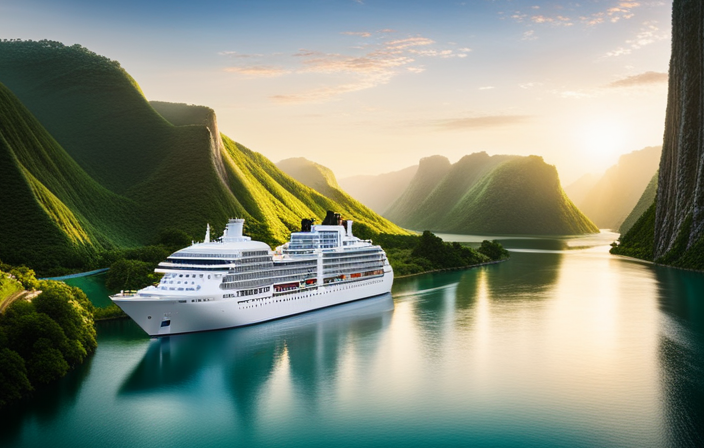On the cruise ship’s deck, the salty breeze tousled my hair while the gentle warmth of the sun kissed my skin. I was filled with pure joy, eager for a journey that offered both adventure and serenity. Yet, as we prepared to set sail, one question remained: is this cruise a closed-loop?
It may seem like a technical term, but it’s a crucial one to understand. A closed-loop cruise refers to a voyage that begins and ends at the same port, typically in the United States. Knowing whether your cruise falls into this category can make a world of difference when it comes to travel documentation and peace of mind.
In this article, I will guide you through the process of determining if your cruise is closed-loop, providing you with the knowledge and confidence to embark on your voyage worry-free. So, let’s dive in and uncover the secrets to ensuring a smooth and hassle-free cruise experience.
Key Takeaways
- Closed-loop cruises begin and end at the same U.S. port, simplifying travel plans and providing increased safety and peace of mind.
- To determine if your cruise is closed-loop, check the departure and arrival ports, look for round-trip itineraries, and confirm there are no customs or immigration procedures at foreign ports.
- Documentation requirements for closed-loop cruises include choosing between a passport or birth certificate and ID, ensuring passport validity, and familiarizing yourself with passport requirements for visited countries.
- Travel insurance is crucial for closed-loop cruises, as it provides financial protection, reimburses non-refundable expenses, and covers medical emergencies. Consult with a travel agent for verification.
Understanding Closed-Loop Cruises
To determine if your cruise is closed-loop, you’ll need to check if your voyage departs and returns to the same U.S. port. Closed-loop cruises offer several benefits, including increased cruise safety and peace of mind for travelers.
When your cruise is closed-loop, it means that you won’t need to worry about obtaining a passport, as these types of cruises typically don’t require one. This can be a huge advantage for those who may not have a passport or prefer not to travel with one.
Additionally, closed-loop cruises allow for easier re-entry into the United States, as you won’t be subjected to the same customs and immigration procedures that are required for international travel.
To ensure that your cruise meets these criteria, you should carefully check your departure and arrival ports.
Check Your Departure and Arrival Ports
When determining if your cruise is closed-loop, it’s important to consider the departure and arrival ports. The disembarkation process and any travel restrictions are key factors in identifying a closed-loop cruise.
Here are some bullet points to help you understand:
- Check if your cruise departs and returns to the same port.
- Look for round-trip itineraries that start and end at the same port.
- Confirm that you won’t need to go through customs or immigration at any foreign port.
- Ensure that you won’t require a passport or visa for the cruise.
By examining these points, you can determine if your cruise is closed-loop and avoid any complications during the disembarkation process or encounters with travel restrictions.
Now, let’s move on to the next section and discuss how to look for round-trip itineraries.
Look for Round-Trip Itineraries
Consider searching for round-trip itineraries, mate, to ensure a smooth sailing experience without any detours or complications.
Round-trip cruises are closed-loop voyages that depart and return to the same port, which simplifies your travel plans.
One of the benefits of booking a round-trip cruise is that it may make you eligible for cruise insurance, which can provide coverage for unforeseen events like trip cancellations or medical emergencies. This insurance can offer peace of mind and protect your investment in case something unexpected happens.
Before finalizing your booking, it’s important to review the cruise line’s policy regarding closed-loop cruises and any additional requirements they may have. By doing so, you can ensure that you have all the necessary documents and information for a worry-free journey.
Review the Cruise Line’s Policy
When planning my cruise, it’s crucial to review the cruise line’s policy to ensure a smooth and hassle-free experience.
One of the key points to consider is contacting the cruise line for confirmation. This allows me to verify important details such as the departure time, itinerary, and any specific requirements.
Additionally, understanding the cruise line’s terms and conditions is essential to avoid any surprises or misunderstandings during the trip. This includes familiarizing myself with cancellation policies, onboard regulations, and any additional fees or charges that may apply.
By taking the time to review and understand these policies, I can confidently embark on my cruise knowing what to expect and how to navigate any potential issues that may arise.
Contacting the Cruise Line for Confirmation
Before you panic, just reach out to the cruise line and find out if your cruise is closed-loop. This is the easiest and most reliable way to get a definitive answer. Give them a call or send an email to their customer service department. They’ll have all the necessary information about your specific cruise and can confirm whether it’s closed-loop or not.
When contacting the cruise line, be prepared with your booking details, such as the ship name, departure date, and reservation number. This’ll help expedite the process and ensure accurate information.
Remember to ask about any travel insurance benefits that may be available to you. It’s also a good idea to compare cruise line policies to see if there are any additional benefits or coverage options that you may want to consider.
Understanding the cruise line’s terms and conditions is important in ensuring a smooth and enjoyable cruise experience.
Understanding the Cruise Line’s Terms and Conditions
To fully enjoy your cruise experience, take a deep dive into the ocean of the cruise line’s terms and conditions. This will allow you to navigate smoothly through any potential challenges that may arise. Understanding refund policies and potential itinerary changes is crucial in ensuring a worry-free vacation.
By familiarizing yourself with the terms and conditions, you can have a clear understanding of what to expect in case of unforeseen circumstances or changes to your cruise plans. These policies outline the cruise line’s guidelines for cancellations, rescheduling, and refunds, providing you with important information to make informed decisions. Additionally, they may detail the cruise line’s responsibility in the event of itinerary changes due to weather conditions or other factors.
By being aware of these terms and conditions, you can confidently plan your cruise and minimize any potential disruptions. Moving forward, it’s essential to verify documentation requirements to ensure a smooth embarkation process.
Verify Documentation Requirements
When it comes to verifying documentation requirements for a cruise, there are important factors to consider. One key point is the choice between using a passport or a birth certificate and ID. It’s crucial to understand the specific requirements of your cruise line and destination.
Additionally, open-loop cruises may require additional documents such as visas or permits, so it’s essential to be well-prepared and informed to ensure a smooth sailing experience.
Passport vs. Birth Certificate and ID
Make sure you have your passport handy, as it’s the most secure form of identification for a closed-loop cruise. Not only does it serve as proof of citizenship, but it also meets the passport requirements set by cruise lines.
When it comes to age restrictions, keep in mind that children and infants also need a passport for closed-loop cruises. To make your journey hassle-free, here are a few things to remember:
- Apply for your passport well in advance to avoid any last-minute rush.
- Double-check the expiration date of your passport to ensure it’s valid for the entire duration of your cruise.
- Make copies of your passport and keep them in a separate location, in case of loss or theft.
- Familiarize yourself with the specific passport requirements of the countries you’ll be visiting.
Now, let’s talk about the additional documents needed for open-loop cruises.
Additional Documents Needed for Open-Loop Cruises
Ensure that you have all the necessary documents, such as visas and entry permits, ready when embarking on an open-loop cruise.
Passport requirements are essential for open-loop cruises, as they’re required for international travel. Make sure your passport is valid for at least six months beyond your intended departure date.
Additionally, check the visa requirements for the countries you’ll be visiting during your cruise. Some destinations may require you to obtain a visa in advance, while others may offer a visa on arrival. It’s crucial to research and comply with these requirements to avoid any issues or delays during your trip.
Once you’ve ensured you have all the necessary documents, the next step is to consider travel insurance. Travel insurance provides financial protection in case of unexpected events or emergencies during your cruise.
Consider Travel Insurance
When planning a closed-loop cruise, it’s important to consider the need for travel insurance. Travel insurance can provide coverage for trip interruptions or cancellations, giving you peace of mind in case unforeseen circumstances arise.
This coverage can help protect your investment and ensure that you aren’t left with any financial burden if your cruise plans are disrupted.
Importance of Travel Insurance for Closed-Loop Cruises
Travel insurance is crucial for closed-loop cruises, as it provides you with peace of mind and financial protection in case of unforeseen events during your trip.
One of the main benefits of travel insurance is coverage for trip cancellation. If you have to cancel your cruise due to unexpected circumstances, such as illness or a family emergency, travel insurance can help reimburse you for the non-refundable expenses.
Additionally, travel insurance also provides coverage for medical emergencies. If you were to fall ill or get injured while on your closed-loop cruise, your travel insurance can help cover the costs of medical treatment, including hospital stays, doctor visits, and medications. This ensures that you receive the necessary care without incurring exorbitant out-of-pocket expenses.
Furthermore, travel insurance also offers coverage for trip interruptions or cancellations, allowing you to recoup some of the costs if your cruise is interrupted or cut short.
Coverage for Trip Interruptions or Cancellations
Now that we understand the importance of travel insurance for closed-loop cruises, let’s explore the coverage it provides for trip interruptions or cancellations. Accidents and unforeseen circumstances can occur at any time, potentially disrupting our carefully planned vacations. Trip cancellation coverage ensures that if you need to cancel your cruise before it even begins, you can receive reimbursement for the non-refundable expenses you’ve incurred. On the other hand, trip interruption coverage protects you if your cruise is cut short due to an unexpected event, such as a medical emergency or a natural disaster. It helps cover the additional expenses you may incur, such as changing flights or accommodation. To further understand your options and make sure you have the right coverage for your cruise, consult with a travel agent who specializes in cruise vacations.
Consult with a Travel Agent
To figure out if your cruise is closed-loop, you should definitely chat with a travel agent who can work their magic and find all the answers for you. A travel agent consultation is the best way to get accurate and up-to-date information about your specific cruise itinerary. They have access to all the necessary details and can verify if your cruise qualifies as closed-loop.
They can check if your departure and return ports are the same, which is a key requirement for a closed-loop cruise. They can also provide information on any additional documentation or requirements needed for your specific cruise, such as passports or visas. By consulting with a travel agent, you can ensure that you have all the necessary information before you embark on your cruise adventure.
Once you have verified the closed-loop status, the next step is to check government travel advisories to stay informed about any potential disruptions or changes to your travel plans.
Check Government Travel Advisories
When planning my cruise, I make sure to check government travel advisories to stay informed about any potential travel warnings or restrictions. This helps me understand if there are any safety concerns or specific guidelines I need to be aware of before embarking on my trip.
Additionally, I stay informed about port closures or changes, as this can affect my itinerary and overall travel experience. By researching and staying updated on these factors, I can ensure a smooth and enjoyable cruise vacation.
Researching Travel Warnings or Restrictions
Before setting sail on your cruise, make sure to research any travel warnings or restrictions that may impact your journey, as they could potentially steer you off course like unexpected waves in the open sea. Staying informed about travel advisories and keeping updated on travel restrictions is crucial to ensuring a smooth sailing experience. One way to do this is by checking government websites or signing up for travel alerts from your country’s embassy. Additionally, it’s important to consult reputable travel websites or forums to gather information from fellow travelers who may have recently visited the same destination. By doing thorough research, you can stay ahead of any potential obstacles that might arise during your cruise. This will allow you to enjoy your vacation worry-free, knowing that you have taken the necessary precautions. Moving forward, it is also essential to stay informed about port closures or changes that could affect your cruise itinerary.
Staying Informed about Port Closures or Changes
Staying informed about port closures or changes is crucial for a seamless and stress-free cruise experience, ensuring that you can smoothly navigate through any unexpected twists and turns along your voyage. To stay updated on port closure updates, it’s important to establish effective communication with your cruise line. Here are some ways to stay informed:
-
Sign up for email alerts or notifications from the cruise line, so you receive immediate updates on any changes to the itinerary.
-
Follow the cruise line’s social media accounts for real-time information and announcements regarding port closures or changes.
-
Check the cruise line’s website regularly for any news or updates on port closures.
-
Consider downloading the cruise line’s mobile app, if available, to receive instant notifications on your smartphone.
By staying informed through these channels, you can plan ahead for disembarkation and ensure a smooth transition from the ship to your next destination.
Plan Ahead for Disembarkation
When planning ahead for disembarkation on a closed-loop cruise, it’s important to consider the customs and immigration procedures that will be involved. These procedures are necessary to ensure a smooth transition from ship to shore. By familiarizing myself with these processes and following any instructions provided by the cruise line, I can ensure a hassle-free experience and make the most of my time in port.
Customs and Immigration Procedures for Closed-Loop Cruises
Upon arrival at the port, passengers on closed-loop cruises can expect the vibrant anticipation of customs and immigration procedures, as they embark on a seamless journey to explore new horizons. Before disembarking, it is important to familiarize yourself with the passport requirements and customs declaration process. Make sure to have a valid passport that will not expire within six months of your cruise’s end date. Additionally, you will need to complete a customs declaration form, where you will declare any items or goods that need to be declared. This is necessary to ensure a smooth transition from ship to shore, allowing you to enjoy your time exploring the exciting destinations that await you.
| Passport Requirements | Customs Declaration |
|---|---|
| Valid and not expiring within six months | Declare any items or goods |
In the subsequent section about the smooth transition from ship to shore, we will discuss the process of disembarkation and the exciting opportunities that await you at each port of call.
Smooth Transition from Ship to Shore
As you step off the ship, get ready to embark on a delightful journey of discovery and embrace the incredible opportunities that lie ashore. The disembarkation process is designed to ensure a smooth transition from ship to shore, allowing you to explore your destination with ease.
Here are three key points to keep in mind during this process:
-
Immigration Procedures: Before leaving the ship, make sure to have all necessary travel documents ready for inspection. This includes your passport, visa (if required), and any other relevant identification.
-
Customs Declaration: Be prepared to declare any items or goods that you’re bringing ashore. Familiarize yourself with the customs regulations of your destination to avoid any issues during inspection.
-
Baggage Collection: Follow the instructions provided by the ship’s crew regarding the collection of your luggage. Keep your baggage claim tags handy to ensure a smooth retrieval process.
With these steps in mind, you can enjoy your cruise with peace of mind, knowing that the disembarkation process and immigration procedures have been taken care of. Transitioning into the subsequent section about ‘enjoy your cruise with peace of mind’ without writing ‘step’, remember that your journey continues ashore with endless possibilities awaiting you.
Enjoy Your Cruise with Peace of Mind
To fully savor your cruise experience, make sure your peace of mind by knowing if your cruise qualifies as a closed-loop. This means that your cruise starts and ends at the same U.S. port, which can offer many benefits, including enhanced travel tips and cruise safety.
When your cruise is closed-loop, it allows for a smooth transition from ship to shore. You won’t have to worry about obtaining a passport or going through customs upon your return. Closed-loop cruises typically have stricter safety protocols in place, ensuring that you can enjoy your vacation with peace of mind.
Before embarking on your cruise, it’s essential to check with your cruise line or travel agent to confirm if your cruise is closed-loop. This information will help you plan and prepare accordingly.
Frequently Asked Questions
How do I book a closed-loop cruise?
To book a closed-loop cruise, I need to follow the cruise line’s booking process. I should be prepared with required documents such as a valid passport or birth certificate and government-issued ID.
What is the difference between a closed-loop cruise and an open-loop cruise?
Closed loop cruises are convenient and cost-effective. They allow me to depart and return to the same U.S. port, while open loop cruises involve different ports. Closed loop cruises provide peace of mind and avoid the hassle of international travel requirements.
Are closed-loop cruises more expensive than open-loop cruises?
Closed-loop cruises are usually not more expensive than open-loop cruises. They are worth it because they offer several benefits such as convenience, as they start and end at the same port, and peace of mind with regards to immigration requirements.
Can I bring my pet on a closed-loop cruise?
Yes, you can bring your pet on a closed-loop cruise. Many cruise lines offer pet-friendly options, like designated pet areas and onboard pet sitting services, so your furry friend can enjoy the voyage too.
What happens if I miss the departure of my closed-loop cruise?
If you miss the departure of your closed-loop cruise, there are consequences. You may be responsible for finding alternative transportation to meet the ship at the next port, and you could incur additional expenses.
Conclusion
In conclusion, it’s always a good idea to double-check if your cruise is a closed-loop. By following the steps outlined in this article, you can ensure a smooth and hassle-free journey.
Remember to review the cruise line’s policy, verify documentation requirements, and consult with a travel agent for any clarifications. Checking government travel advisories and planning ahead for disembarkation will also provide you with peace of mind during your trip.
So go ahead and embark on your closed-loop cruise adventure, knowing that you’re fully prepared and ready to enjoy every moment. Bon voyage!
Meet Asra, a talented and adventurous writer who infuses her passion for exploration into every word she writes. Asra’s love for storytelling and her insatiable curiosity about the world make her an invaluable asset to the Voyager Info team.
From a young age, Asra was drawn to the power of words and their ability to transport readers to far-off lands and magical realms. Her fascination with travel and cultures from around the globe fueled her desire to become a travel writer, and she set out on a journey to turn her dreams into reality.











